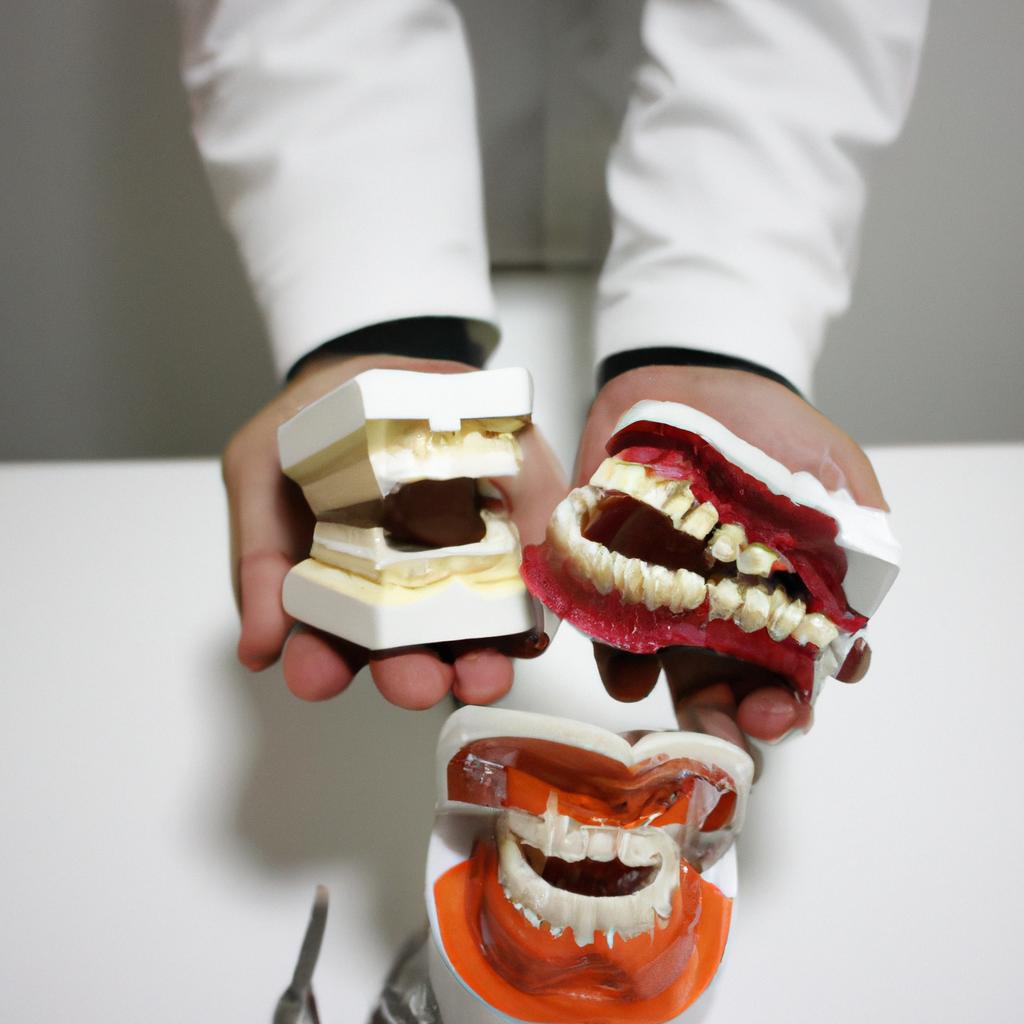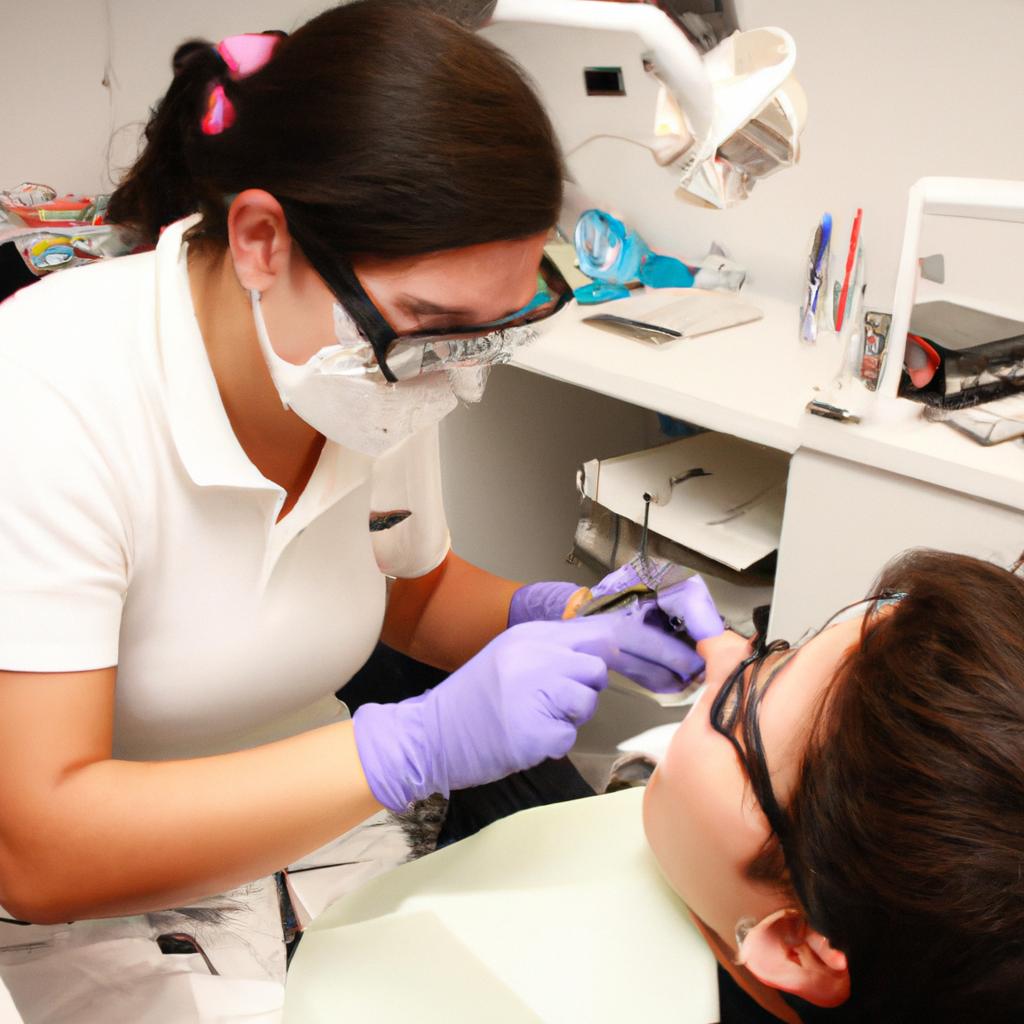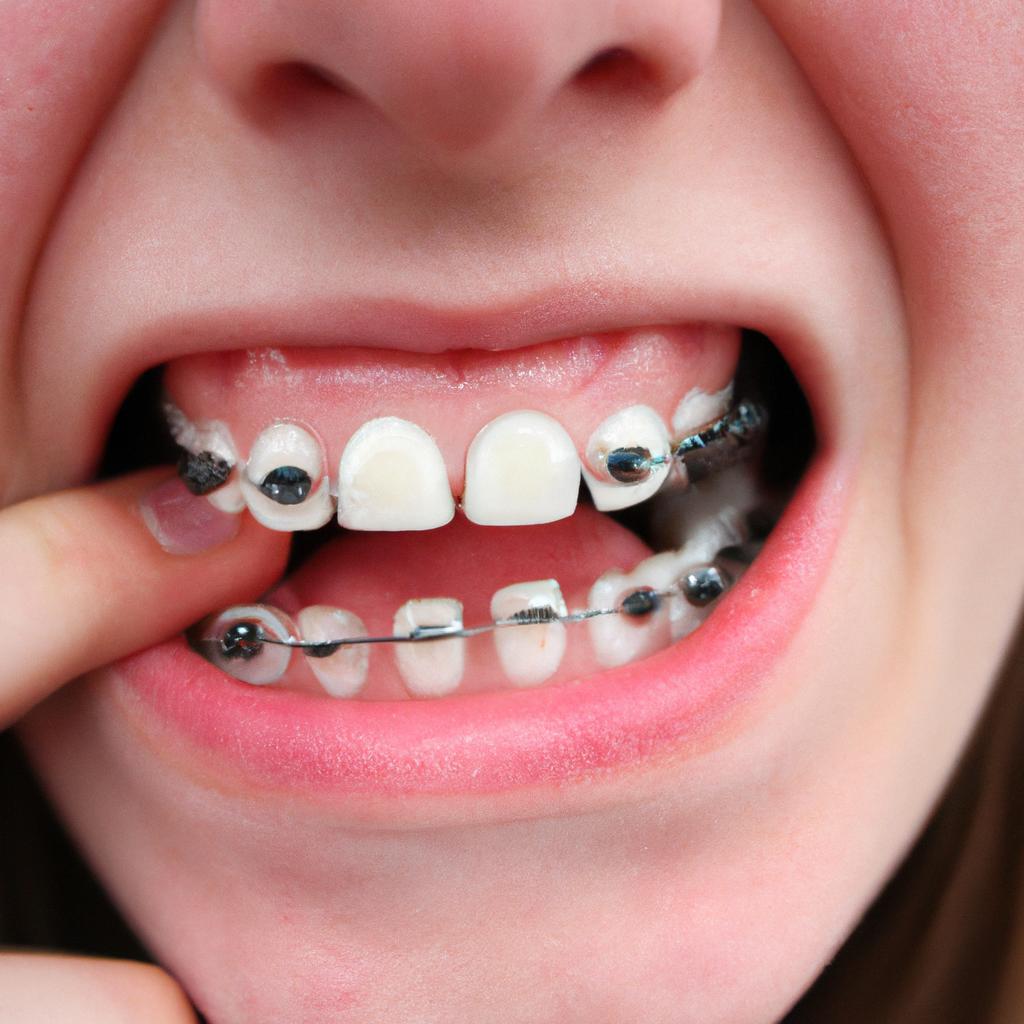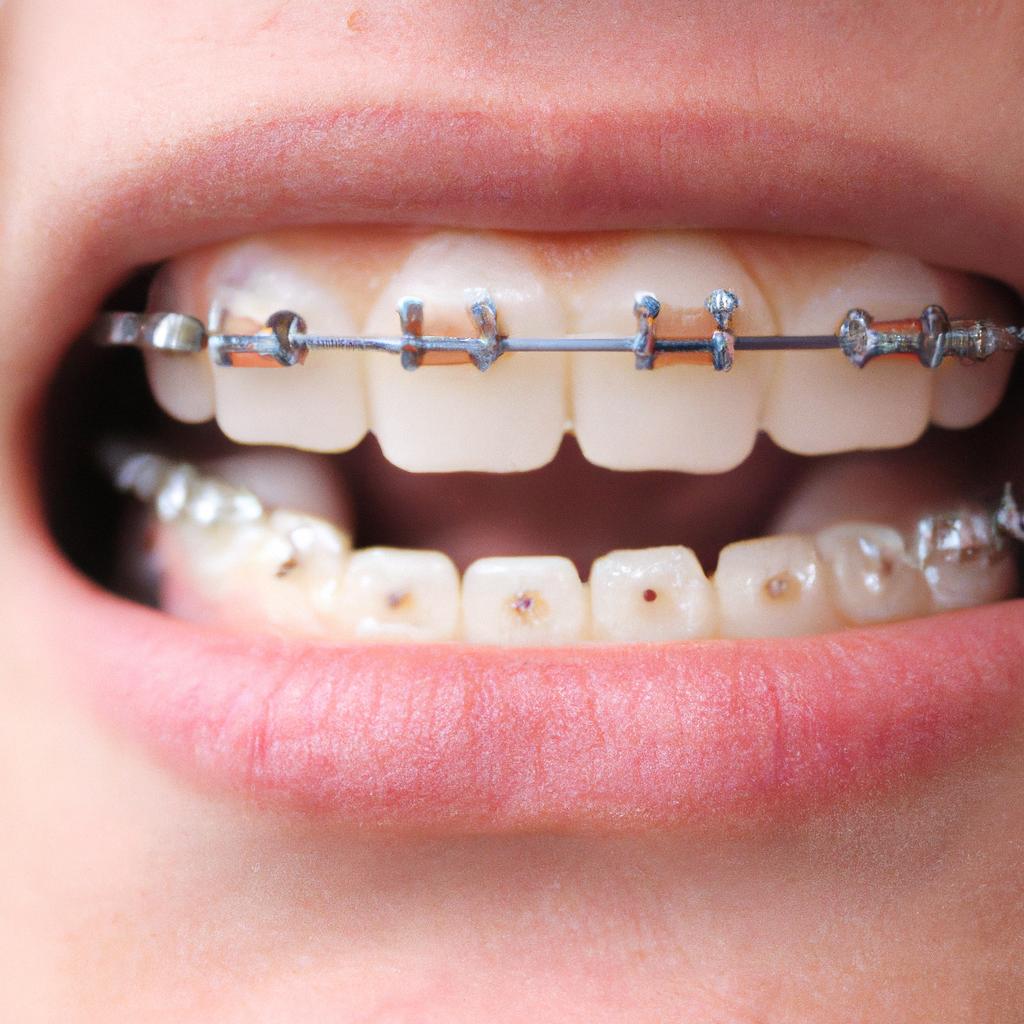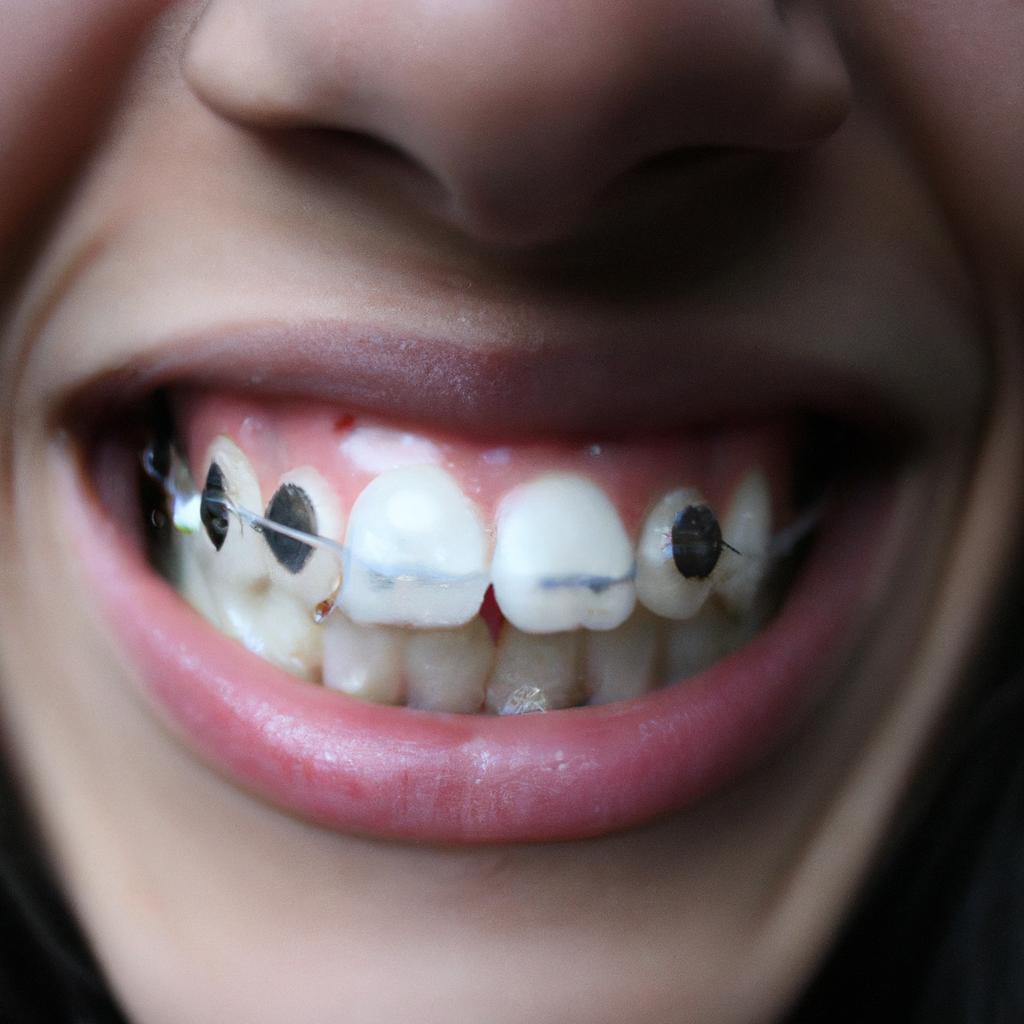Orthodontics: The Dental Specialty for Effective Dental Alignment

Orthodontics is a dental specialty that focuses on the diagnosis, prevention, and treatment of dental irregularities such as misalignment and malocclusion. This specialized branch of dentistry plays a crucial role in enhancing both the aesthetic appearance and functionality of an individual’s teeth. For instance, consider the case study of Sarah, a 14-year-old girl with crowded teeth and a severe overbite. Orthodontic intervention was necessary to address her concerns and improve her oral health.
Through various techniques like braces, retainers, and aligners, orthodontists aim to correct dental alignment issues by gradually applying controlled forces to move the teeth into their optimal positions. The primary objective is not only to achieve straighter teeth but also to establish proper occlusion for better chewing efficiency and reduce strain on the jaw joints. By doing so, orthodontics contributes significantly to improving overall oral health while simultaneously boosting self-confidence through a more harmonious smile.
Furthermore, orthodontic treatments are not limited to children or teenagers; adults can also benefit from them. As individuals age, tooth movement may occur due to factors such as natural growth or loss of teeth. Additionally, some adults may have missed out on orthodontic treatment during their younger years. Thus, seeking orth odontic treatment as an adult can help address any existing misalignment issues, improve oral health, and enhance the appearance of their smile. Adult orthodontics typically involve a combination of traditional braces, clear aligners, or other specialized appliances to achieve the desired results.
In summary, orthodontics is a dental specialty that focuses on correcting dental irregularities and improving overall oral health. It involves various techniques and appliances to gradually move teeth into proper alignment and establish optimal occlusion. Whether for children, teenagers, or adults, orthodontic treatments can provide numerous benefits in terms of both aesthetics and functionality.
Understanding Clear Aligners
Imagine a scenario where an individual named Sarah is self-conscious about her misaligned teeth. She hesitates to smile freely, fearing judgment and social discomfort. However, there is hope for individuals like Sarah through the use of clear aligners—an increasingly popular orthodontic treatment option that offers effective dental alignment with minimal visibility.
Clear aligners are transparent, custom-made trays designed to gradually shift teeth into their desired positions. These removable appliances provide a discreet alternative to traditional braces, making them particularly appealing for those who prioritize aesthetics during their orthodontic journey. By utilizing advanced 3D imaging technology, orthodontists create personalized treatment plans tailored to each patient’s unique needs. This ensures that every set of clear aligners guides teeth towards optimal alignment over time.
- Enhanced confidence: With clear aligners discreetly working on one’s teeth, individuals can regain their confidence and feel more comfortable expressing themselves.
- Improved appearance: Clear aligners offer a visually appealing solution by avoiding the bulkiness associated with conventional braces.
- Convenient oral care routine: The ability to remove clear aligners allows for easy brushing and flossing without any obstructions.
- Minimal impact on daily life: Unlike traditional braces that may cause discomfort or restrictions in eating certain foods, clear aligners allow individuals to continue enjoying their favorite meals without worry.
Moreover, it is crucial to recognize the effectiveness of clear aligner treatments through real-life examples. The table below showcases how different patients achieved significant dental alignment improvements using this modern orthodontic approach:
| Patient Name | Initial Teeth Alignment | Final Teeth Alignment |
|---|---|---|
| John | Moderate crowding | Straightened |
| Lisa | Overbite | Corrected |
| David | Crossbite | Aligned properly |
| Emma | Spacing between teeth | Closed |
In summary, clear aligners offer a discreet and effective solution for dental alignment concerns. By providing enhanced confidence, improved appearance, convenience in oral care routines, and minimal disruption to daily life, they have become increasingly popular among orthodontic patients. However, achieving lasting results requires continued efforts even after the treatment period ends. In the subsequent section, we will explore the importance of retainers in maintaining the achieved dental alignment.
(Note: The transition into the subsequent section about “The Importance of Retainers in Dental Alignment” can be made by mentioning how ongoing efforts are necessary to preserve the desired outcome.)
The Importance of Retainers in Dental Alignment
Understanding Clear Aligners has shed light on one popular method of dental alignment. However, it is essential to recognize the importance of retainers in maintaining the effectiveness and longevity of orthodontic treatment. Retainers play a vital role in ensuring that teeth remain aligned after the use of clear aligners or other orthodontic appliances.
To illustrate this point, let us consider a hypothetical case study involving a patient named Sarah. After undergoing clear aligner treatment for several months, Sarah’s teeth have achieved optimal alignment. At this stage, her orthodontist recommends incorporating retainers into her daily oral care routine to preserve the progress made during treatment.
Retainers offer numerous benefits in maintaining dental alignment:
- Stability: Once the active phase of treatment concludes, wearing retainers helps stabilize the teeth in their new positions by preventing them from shifting back to their original misaligned state.
- Bite Alignment: Retainers also aid in achieving proper bite alignment by ensuring that upper and lower teeth fit together harmoniously.
- Comfort: Although initially unfamiliar, patients often adapt quickly to wearing retainers as they become accustomed to their presence within the mouth.
- Long-Term Results: Consistent usage of retainers over time can help sustain the desired outcomes obtained through orthodontic treatments such as clear aligners.
Let us now explore these benefits further with a table comparing different types of retainers based on material composition and ease of use:
| Type | Material Composition | Ease of Use |
|---|---|---|
| Hawley | Acrylic and Wire | Requires removal for eating or brushing |
| Essix | Clear Plastic | Removable for special occasions |
| Fixed | Bonded wire | No need for regular removal |
As seen above, each type offers its distinct advantages and considerations regarding maintenance and convenience. Patients should consult their orthodontist to determine which retainer option suits their specific needs.
By diligently wearing retainers as instructed by the orthodontist, individuals like Sarah can secure their newly aligned smiles for years to come. With a firm grasp of the significance of retainers in dental alignment maintenance, we can now transition into exploring different types of orthodontic appliances that serve unique purposes in achieving optimal oral health and aesthetics.
Exploring Different Types of Orthodontic Appliances
Building on the importance of retainers in dental alignment, let us now explore different types of orthodontic appliances that are commonly used to achieve effective dental alignment.
Types of Orthodontic Appliances
Orthodontists employ a range of appliances tailored to meet individual patient needs and address specific dental alignment issues. These appliances can be classified into three main categories: fixed braces, removable aligners, and functional appliances. Each type offers distinct advantages depending on the severity of misalignment and patient preferences.
-
Fixed Braces:
Fixed braces consist of brackets bonded to the teeth’s surfaces, interconnected by archwires that apply consistent pressure to gradually shift teeth into their desired positions. This method is particularly effective for complex cases involving severe crowding or malocclusion. Patients often choose from various materials such as stainless steel, ceramic, or lingual (placed behind the teeth) braces based on aesthetic concerns. -
Removable Aligners:
Removable aligners have gained popularity due to their discreet appearance and convenience during eating or cleaning routines. These transparent plastic trays are custom-made using computer-aided design technology to progressively move teeth over time. They offer a viable alternative for patients with mild-to-moderate malocclusions who desire flexibility without compromising aesthetics. -
Functional Appliances:
Functional appliances aim to correct skeletal discrepancies primarily by modifying jaw growth patterns in growing individuals. These devices utilize forces generated by muscle activity and encourage favorable facial bone development while simultaneously improving occlusion. Common examples include Herbst appliances and Twin Block systems which help reposition the lower jaw relative to the upper one.
To better understand the impact of orthodontic treatment beyond dental alignment, consider these emotional benefits:
- Enhanced self-confidence through improved smile aesthetics.
- Increased oral function leading to improved speech clarity and chewing efficiency.
- Reduced risk of tooth decay, gum disease, and temporomandibular joint disorders.
- Alleviation of potential long-term issues such as premature wear, jaw joint pain, and headaches.
| Types of Orthodontic Appliances | Advantages |
|---|---|
| Fixed Braces | – Effective for complex cases – Various material options available |
| Removable Aligners | – Discreet appearance – Convenience during eating and cleaning routines |
| Functional Appliances | – Correct skeletal discrepancies in growing individuals |
In conclusion, orthodontics offers a range of appliances tailored to address various dental alignment needs. From fixed braces providing comprehensive treatment to removable aligners offering flexibility and discreetness, patients can choose the most suitable option based on their unique requirements. Additionally, functional appliances focus not only on teeth but also on modifying jaw growth patterns. By understanding these different types of Orthodontic Appliances, we can better appreciate the benefits they bring in achieving effective dental alignment.
Moving forward, let us now delve into the specific benefits that traditional braces offer in dental alignment without using any transition words like “step.”
The Benefits of Braces in Dental Alignment
Imagine a teenager named Sarah who has been struggling with dental misalignment for most of her life. Her teeth are crooked, causing discomfort and affecting her self-confidence. After consulting with an orthodontist, she learns about the various types of orthodontic appliances available to correct her dental alignment issues. Let us delve into the world of orthodontics by exploring these different types in detail.
Traditional braces: Traditional metal braces have long been the go-to option for correcting dental misalignment. These appliances consist of brackets that are bonded to each tooth and connected by archwires, which apply gentle pressure to gradually move the teeth into their desired positions. Although traditional braces may seem bulky or unsightly at first glance, they remain one of the most effective solutions for complex cases involving severe malocclusions.
Clear aligners: Clear aligners have gained popularity among patients seeking a more discreet treatment option. Made from transparent plastic material, these custom-made trays fit over the teeth and exert controlled force to shift them into proper alignment. Clear aligner systems such as Invisalign® allow patients like Sarah to undergo treatment without drawing attention to their smile during social interactions.
Lingual braces: For individuals desiring even greater aesthetic discretion, lingual braces offer a hidden alternative. Unlike traditional braces that are placed on the front surface of the teeth, lingual braces are attached behind them, making them virtually invisible when smiling or talking. This innovative approach allows patients to maintain their confidence throughout their orthodontic journey without compromising results.
Now let’s explore how these different orthodontic appliances can benefit individuals seeking dental alignment:
- Enhanced aesthetics: Clear aligners and lingual braces provide a more aesthetically pleasing appearance compared to traditional metal braces.
- Improved comfort: Advances in materials and design have made modern orthodontic appliances more comfortable to wear than ever before.
- Convenience and flexibility: Certain orthodontic appliances, like clear aligners, can be removed while eating or brushing teeth, offering greater convenience and flexibility in daily life.
- Predictable results: Orthodontic treatment with various appliances has shown to produce predictable and effective outcomes for patients of all ages.
In summary, the field of orthodontics offers a range of different appliance options to address dental misalignment. Traditional braces remain a reliable choice, while clear aligners and lingual braces offer discreet alternatives. These treatments provide enhanced aesthetics, improved comfort, convenience, and predictability for those seeking optimal dental alignment.
Transitioning into “The Role of Orthodontic Treatment Planning,” it is crucial to understand how orthodontists determine the most suitable course of action for each patient’s unique needs.
The Role of Orthodontic Treatment Planning
The Role of Orthodontic Treatment Planning
Effective dental alignment requires careful planning and consideration to ensure optimal results. Orthodontic treatment planning plays a crucial role in determining the appropriate course of action for each individual patient. By evaluating various factors, orthodontists are able to develop personalized treatment plans that address specific dental concerns.
For instance, consider the case of Sarah, a 14-year-old girl with crowded teeth and an overbite. Through thorough examination and analysis, her orthodontist determined that braces would be the most suitable option to correct her dental issues. This involved creating a comprehensive treatment plan tailored to Sarah’s unique needs, taking into account factors such as the severity of misalignment, age, bone structure, and overall oral health.
Orthodontic Treatment Planning involves several key considerations:
-
Diagnosis: The first step in developing a treatment plan is accurate diagnosis. Orthodontists utilize various diagnostic tools like X-rays, photographs, and impressions to assess the current condition of the teeth and jaws. This helps determine the extent of misalignment and identify any underlying issues that may impact treatment decisions.
-
Goal Setting: Once a diagnosis is made, setting clear goals becomes essential. Orthodontists work closely with patients to understand their desired outcomes from orthodontic treatment. Whether it’s achieving straighter teeth or improving bite functionality, establishing these goals allows for a more targeted approach towards effective dental alignment.
-
Treatment Options: There are multiple orthodontic treatment options available today, including traditional braces, clear aligners (such as Invisalign), lingual braces (placed on the backside of teeth), and removable appliances. During the treatment planning phase, orthodontists carefully evaluate which option will best address the patient’s needs while considering practical aspects like duration of treatment and comfort level.
-
Long-Term Stability: A successful outcome doesn’t just involve initial alignment but also focuses on long-term stability. Orthodontic treatment planning takes into account factors that may affect the longevity of results, such as retention techniques (e.g., retainers) and post-treatment follow-up appointments to monitor progress.
In summary, orthodontic treatment planning plays a crucial role in achieving effective dental alignment. By considering various factors, orthodontists develop personalized treatment plans tailored to each patient’s needs. Through accurate diagnosis, goal setting, exploring different treatment options, and ensuring long-term stability, orthodontists strive to provide optimal outcomes for their patients.
Moving forward, let’s explore some key considerations for an orthodontic consultation where these aspects are further discussed.
Key Considerations for Orthodontic Consultation
Imagine a 14-year-old named Emily who visits an orthodontist seeking treatment for her misaligned teeth. The orthodontist carefully assesses her dental condition, taking into consideration various factors such as the severity of misalignment, facial structure, and overall oral health. This initial consultation marks the beginning of a comprehensive treatment planning process that guides orthodontists in designing personalized strategies to achieve effective dental alignment.
Orthodontic treatment planning involves several key considerations that ensure optimal outcomes for patients like Emily. Firstly, orthodontists evaluate the patient’s medical history and conduct a thorough examination of their dental structures using diagnostic tools such as X-rays, photographs, and impressions. These assessments provide crucial information about the current positioning of teeth, jaw relationships, and any existing abnormalities or underlying issues.
Once all necessary data is gathered, orthodontists move on to formulating a customized treatment plan tailored to address specific malocclusions or irregularities identified during the evaluation stage. This detailed plan serves as a roadmap for achieving desired tooth movements and aligning the jaws correctly over time. It may involve the use of various orthodontic appliances such as braces or clear aligners along with additional techniques like interproximal reduction or elastics.
To effectively communicate these treatment plans with patients and other healthcare professionals involved in their care, orthodontists often employ visual aids such as bullet point lists highlighting key aspects of the proposed interventions:
- Comprehensive assessment of dental structures
- Identification of malocclusions and underlying issues
- Development of personalized treatment plan
- Utilization of appropriate orthodontic appliances and techniques
Furthermore, creating concise tables can help summarize important details related to treatment planning while evoking an emotional response from readers:
| Key Considerations | Benefits | Challenges |
|---|---|---|
| Customized approach | Achieving ideal dental alignment | Longer treatment duration |
| Multidisciplinary collaboration | Improved oral health outcomes | Potential discomfort or soreness |
| Patient involvement | Enhanced aesthetic appearance | Maintenance and care requirements |
| Long-term stability | Functional improvements | Financial considerations |
In summary, orthodontic treatment planning plays a crucial role in guiding the course of dental alignment interventions. Through comprehensive assessments and personalized strategies, orthodontists aim to achieve optimal outcomes for their patients. The next section will delve into the process of clear aligner treatment, shedding light on its advantages and considerations.
Understanding the importance of effective treatment planning lays the foundation for exploring one popular method known as clear aligner treatment.
The Process of Clear Aligner Treatment
Continuing from the previous section, let us explore in detail the process of clear aligner treatment. To better illustrate this, we will consider a hypothetical case study involving a patient named Sarah who seeks orthodontic alignment to correct her crowded teeth.
Sarah’s initial consultation with an orthodontist revealed that she would be an ideal candidate for Clear Aligners due to her mild crowding issue and overall good oral health. The orthodontist explained that clear aligners are custom-made trays designed to gradually shift the teeth into proper alignment over time. This non-invasive alternative offers advantages such as improved aesthetics, ease of use, and increased comfort compared to traditional braces.
When undergoing clear aligner treatment, several essential steps need to be followed:
-
Initial Assessment:
- Evaluation of dental records, including X-rays and impressions.
- Identification of specific concerns or abnormalities in tooth positioning.
-
Development of Treatment Plan:
- Customization of clear aligners using advanced computer technology.
- Creation of a sequential series of aligners based on the desired outcome.
-
Wearing Clear Aligners:
- Consistent wearing of each set of aligners for approximately 20-22 hours per day.
- Changing to new sets every one to two weeks as directed by the orthodontist.
-
Monitoring Progress:
- Regular check-ups with the orthodontist to assess progress and make necessary adjustments if required.
Throughout Sarah’s journey, she experienced gradual improvements in her dental alignment thanks to diligent adherence to wearing her clear aligners and regular follow-up appointments with her orthodontist. Her treatment duration lasted around nine months, resulting in beautifully aligned teeth that enhanced both her smile and overall oral health.
In the subsequent section, we will delve into the importance of maintaining dental alignment with retainers. By understanding this crucial aspect, patients like Sarah can enjoy long-lasting results from their orthodontic treatment, ensuring a healthy and confident smile for years to come.
Maintaining Dental Alignment with Retainers
Orthodontic treatment with clear aligners is a highly effective method for achieving dental alignment. However, once the treatment is complete and the aligners are no longer necessary, it becomes essential to maintain the achieved dental alignment. This can be done by using retainers.
Retainers play a crucial role in preventing any relapse or shifting of the teeth after orthodontic treatment. They help stabilize the newly aligned teeth and ensure that they remain in their optimal position. Let us consider an example to illustrate this point: imagine a patient who has successfully completed clear aligner treatment and obtained beautifully straightened teeth. Without wearing retainers, there is a risk that slight movements may occur over time due to natural forces within the mouth, such as chewing or tongue pressure. Wearing retainers helps counteract these forces and maintain the hard-earned results.
To effectively maintain dental alignment with retainers, here are some key points to keep in mind:
- Consistency: It is important to wear your retainer consistently as prescribed by your orthodontist. Initially, you might need to wear them full-time (except when eating) and then transition to wearing them only at night.
- Proper care: Clean your retainers regularly using mild soap and warm water or follow specific cleaning instructions provided by your orthodontist. Avoid exposing them to excessive heat or leaving them exposed to bacteria.
- Check-ups: Regularly visit your orthodontist for check-ups to evaluate the fit of your retainers and make adjustments if needed.
- Replacement: Over time, retainers may become worn out or lose their effectiveness. If this occurs, consult with your orthodontist about getting new ones.
To further emphasize the importance of maintaining dental alignment through retainer use, let’s take a look at this emotional bullet-point list:
- Retainers ensure the longevity of your smile.
- Consistent retainer use safeguards against potential relapse.
- Proper care and maintenance of retainers are crucial for optimal results.
- Regular check-ups with your orthodontist help address any concerns or issues.
Additionally, we can present a table outlining the benefits of wearing retainers:
| Benefits of Wearing Retainers |
|---|
| Prevents teeth from shifting back to their original positions. |
| Maintains improved oral health and function. |
As you can see, using retainers after clear aligner treatment is vital in maintaining dental alignment achieved during orthodontic therapy. By following these guidelines and understanding the significance of regular retainer wear, individuals can enjoy long-lasting results that contribute to overall oral well-being.
Transition into subsequent section on “Choosing the Right Orthodontic Appliance for You”: Considering different patients’ needs, it becomes essential to explore various options when selecting an appropriate orthodontic appliance tailored specifically to one’s requirements.
Choosing the Right Orthodontic Appliance for You
Imagine a young individual named Sarah who just completed her orthodontic treatment. After wearing braces for two years, she is thrilled to finally have straight teeth and an improved smile. However, the journey towards achieving optimal dental alignment doesn’t end here. To ensure that her teeth stay in their new positions, Sarah’s orthodontist recommends using retainers.
Retainers play a crucial role in maintaining dental alignment after orthodontic treatment. These custom-made appliances are typically made of plastic or metal wires and are designed to hold teeth in place while surrounding tissues adjust to their new positions. There are several types of retainers available today, including removable and fixed options.
To understand the importance of retainers further, let us explore some key reasons why they are essential:
-
Stability: Teeth have a natural tendency to shift back to their original positions even after completing orthodontic treatment. By wearing retainers as instructed by your orthodontist, you can help stabilize your teeth and prevent them from shifting.
-
Tissue Adaptation: After removing braces, it takes time for the tissues around your teeth to adapt to their new positions fully. Wearing retainers aids this process by providing support and allowing proper adjustment over time.
-
Bite Improvement: In certain cases, retainers can also aid in improving bite discrepancies by guiding teeth into better alignment when worn consistently.
-
Long-Term Results: Investing time and effort into wearing retainers diligently helps ensure long-lasting results from your orthodontic treatment.
| Type of Retainer | Description |
|---|---|
| Hawley Retainer | A removable retainer made of acrylic material with wire clasps that wrap around specific teeth for stability |
| Clear Aligner Retainer | Similar to clear aligners used during orthodontic treatment; these retainers are thin, transparent trays that fit over the teeth |
| Fixed Retainer | A wire bonded to the back surfaces of specific teeth using dental cement for continuous support |
By understanding the significance of using retainers and being aware of the various types available, individuals like Sarah can actively participate in maintaining their newly aligned smiles. In our next section, we will address common misconceptions about braces and debunk them to provide a more accurate understanding of orthodontic treatment.
Transitioning into the subsequent section on “Common Misconceptions about Braces,” it is essential to dispel certain misunderstandings surrounding orthodontic treatment. This will enable individuals seeking information about braces to make informed decisions regarding their oral health journey.
Common Misconceptions about Braces
Transitioning from the previous section, let us now explore some common misconceptions about braces. To illustrate their impact on individuals’ lives, consider a hypothetical case of Sarah, a 15-year-old student who felt self-conscious about her misaligned teeth and hesitant to smile in social settings.
Misconception #1: Braces are only for children or teenagers.
Contrary to popular belief, orthodontic treatment is not limited to young individuals. Many adults also undergo dental alignment procedures to improve their oral health and enhance their overall appearance.
Misconception #2: Wearing braces is painful and uncomfortable.
While it’s true that adjusting to braces may initially cause discomfort as your mouth adapts to them, modern orthodontic technology has significantly improved over the years. Today, there are various alternatives available that offer greater comfort without compromising effectiveness.
To further understand these misconceptions and address any concerns you might have, here is a bullet point list highlighting key points:
- Orthodontic treatments can be beneficial at any age.
- Modern braces have evolved to provide enhanced comfort during wear.
- Proper maintenance and regular visits ensure optimal results.
- Improved self-confidence often accompanies successful treatment outcomes.
Additionally, let us delve into a comparative analysis using a table format showcasing different types of orthodontic appliances along with their advantages:
| Type of Appliance | Advantages |
|---|---|
| Traditional metal braces | Most cost-effective option |
| Ceramic braces | Less noticeable than metal braces |
| Lingual braces | Invisible when smiling |
| Clear aligners | Removable for convenience |
In conclusion, addressing common misconceptions surrounding orthodontics allows individuals like Sarah to make informed decisions regarding their dental alignment. By dispelling these myths, we can encourage individuals of all ages to seek orthodontic treatment and enjoy the benefits it offers.
With a better understanding of common misconceptions, let us now explore how personalized orthodontic treatment plans cater to individual needs and goals without compromising on effectiveness.
Personalized Orthodontic Treatment Plans
Orthodontics, a specialized branch of dentistry focused on correcting dental misalignments and irregularities, offers various treatment options tailored to individual needs. By employing advanced techniques and technologies, orthodontists can create personalized treatment plans that address specific concerns effectively. This section will explore the benefits of personalized orthodontic treatment plans in achieving optimal dental alignment.
To illustrate the significance of personalized treatment plans, let us consider an example. Imagine a patient named Sarah who seeks orthodontic treatment for crowded teeth and a slight overbite. With a thorough examination and evaluation by an experienced orthodontist, Sarah’s unique case is analyzed, taking into account factors such as her age, oral health condition, severity of misalignment, facial structure, and personal preferences. Based on this comprehensive assessment, the orthodontist devises a customized treatment plan for Sarah that involves using clear aligners to gradually shift her teeth into proper alignment while addressing her specific concerns.
Personalized orthodontic treatment plans offer several advantages over generic approaches:
- Tailored Solutions: Every individual has different dental issues and goals when seeking orthodontic treatment. A personalized approach allows the orthodontist to develop a plan specifically designed to meet each patient’s unique needs.
- Enhanced Effectiveness: By considering various factors like age, tooth structure, and jaw development during treatment planning, orthodontists can optimize the effectiveness of interventions. This leads to better results in terms of both aesthetics and functionality.
- Improved Patient Experience: Personalized care fosters greater patient satisfaction by acknowledging their specific requirements and adapting treatments accordingly. It ensures that patients feel involved throughout the process and are more likely to comply with instructions.
- Long-term Benefits: An individually tailored approach considers not only immediate correction but also long-term stability. Orthodontists aim to achieve lasting results that maintain improved dental alignment well into the future.
Table – Emotional Impact
| Emotion | Explanation |
|---|---|
| Confidence | A straight and aligned smile can boost self-confidence, helping individuals feel more assured. |
| Happiness | Improving dental alignment can enhance overall facial aesthetics, leading to increased happiness. |
| Comfort | Correcting misalignments can alleviate oral discomfort caused by issues like bite problems. |
| Health | Properly aligned teeth are easier to clean, reducing the risk of tooth decay and gum diseases. |
In summary, personalized orthodontic treatment plans offer tailored solutions that effectively address individual dental misalignment concerns. By considering various factors during treatment planning, orthodontists optimize outcomes while enhancing patient satisfaction and long-term stability. The emotional impact of achieving optimal dental alignment includes improved confidence, happiness, comfort, and overall oral health.
Understanding the benefits of personalized treatment plans sets the stage for exploring what patients should expect during an Orthodontic Consultation.
What to Expect During an Orthodontic Consultation
Orthodontics: The Dental Specialty for Effective Dental Alignment
Personalized Orthodontic Treatment Plans have proven to be essential in achieving optimal dental alignment. By tailoring treatment plans to the specific needs of each patient, orthodontists can provide effective solutions that cater to individual concerns and goals. This section will explore the importance of personalized treatment plans in orthodontics and highlight their benefits through a hypothetical case study.
Imagine a teenager named Sarah who seeks orthodontic treatment due to misaligned teeth. During her initial consultation with an orthodontist, a thorough examination is conducted, including X-rays, photographs, and impressions of her teeth. Through these assessments, the orthodontist identifies Sarah’s unique dental issues, such as overcrowding and malocclusion (improper bite).
Based on this analysis, the orthodontist develops a personalized treatment plan specifically designed for Sarah. This plan includes several stages:
-
Preliminary Phase:
- Placement of spacers between molars to create space for future tooth movement.
- Installation of braces on selected teeth to initiate alignment.
-
Active Phase:
- Regular adjustments and tightening of braces to guide teeth into proper position.
- Periodic replacement or repositioning of brackets and wires based on progress.
-
Finishing Phase:
- Removal of braces once desired alignment is achieved.
- Placement of retainers to maintain newly aligned teeth over time.
A personalized treatment plan offers numerous advantages compared to standardized approaches:
- Customization: Tailored plans address specific dental concerns efficiently.
- Efficiency: Targeted treatments yield quicker results than generalized methods.
- Patient satisfaction: Individualized care ensures patients’ preferences are considered.
- Long-term success: Personalized retention strategies help maintain lasting results.
To further illustrate the significance of personalized treatment plans in orthodontics, consider Table 1 below which showcases various outcomes based on different approaches:
| Standard Approach | Personalized Approach | |
|---|---|---|
| Treatment Time | Longer | Shorter |
| Patient Satisfaction | Variable | Higher |
| Overall Cost | Potentially lower | Justified by the effectiveness |
This table emphasizes how personalized orthodontic treatment plans can lead to shorter treatment times, higher patient satisfaction, and overall cost-effectiveness.
In summary, orthodontics relies on personalized treatment plans to achieve effective dental alignment. Through a hypothetical case study of Sarah’s journey, we have seen the importance of tailoring treatments to address specific concerns. The advantages of customized approaches are evident in terms of efficiency, patient satisfaction, and long-term success. By adopting individualized strategies, orthodontists can provide patients with optimal results while considering their unique needs and preferences.

